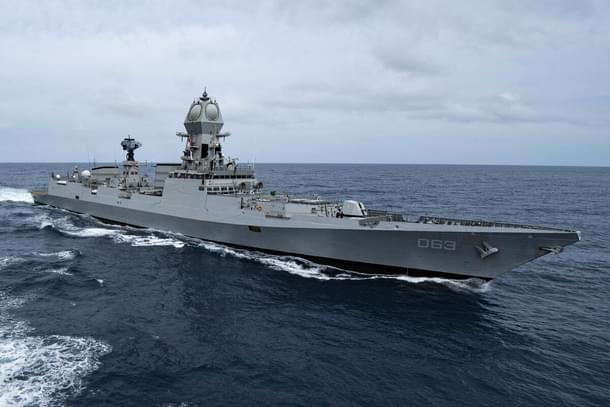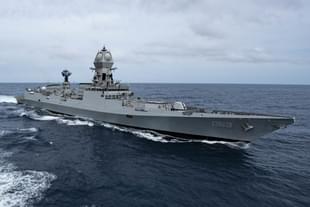Defence
Indian Navy Is Making Its Best Ever Case For Why It Needs More Assets
Ujjwal Shrotryia
Jan 31, 2024, 04:51 PM | Updated 05:25 PM IST
Save & read from anywhere!
Bookmark stories for easy access on any device or the Swarajya app.


The Indian Ocean Region (IOR) has recently witnessed heightened tensions, primarily due to the Iranian-supported Yemeni Houthi militia targeting merchant shipping in the Red Sea.
This aggressive behaviour is seen as retaliation against Israeli actions in the Hamas-controlled Gaza Strip. Moreover, the situation has been exacerbated by Somali pirates who, emboldened by the Houthi missile attacks, have ramped up their hijacking attempts on civilian ships.
In response to these escalating threats, the Indian Navy (IN) has stepped up its presence in the region, deploying 10 warships, including five destroyers — INS Kolkata, INS Kochi, INS Mormugao, INS Chennai, and INS Visakhapatnam.
Alongside these, a logistics tanker, P-8I Poseidon maritime surveillance aircraft, and MQ-9 Sea Guardian drones have been strategically positioned to ensure maritime security.
These assets has enabled the Indian Navy to swiftly address distress calls from two merchant vessels hit by Houthi missile strikes and successfully thwart two hijacking attempts by Somali pirates, all within a fortnight.
These operations have cemented the Indian Navy's role as the net security provider — chief protector in the area, ensuring safe passage for ships and maintaining peace in the waters.
This region is critical for the Indian economy.
Given that nearly 65 per cent of India's crude oil imports, amounting to $105 billion, along with substantial volumes of the nation's merchandise imports (50 per cent) and exports (60 per cent), transit through the Red Sea route, the Indian Navy's role cannot be overstated.
Any disruptions in this vital maritime corridor could have grave implications on India's trade.
Thus, these actions of the Indian Navy — ensuring safety for commercial shipping — are making the best case for why it needs more assets, and faster — a case that it has tried to make in the past but failed.
The navy has been a flagbearer of atmanirbhar, focusing on domestically produced weapons and equipment, even more so than the army and air force.
Most of its new frigate and destroyer fleet, including Kolkata and Vishakhapatnam class destroyers, Shivalik and Nilgiri class frigates, Kamorta class corvettes, and various patrol boats and offshore patrol vehicles, not to mention the INS Vikrant aircraft carrier, are made in India.
With plans to induct almost exclusively Indian-made ships in the next decade and a half, including a second aircraft carrier, Project-75I and Scorpene class submarines, and P-18 class destroyers, the Indian Navy's commitment to domestic production is unwavering.
Yet, it faces challenges due to budgetary constraints. As the former Navy Chief Admiral Karambir Singh pointed out, the navy's share of the total defence budget has diminished, from 18 per cent in 2012-13 to just 13 per cent in 2019-20.
Consequently, critical acquisitions such as the 65,000-tonne aircraft carrier, diesel-electric submarines, landing helicopter docks, and multi-role helicopters have been delayed due to funding shortfalls.
As India's exports grow, ensuring the safety of sea lanes essential for such trade will become increasingly important at a time when China's forays into the Indian Ocean continue to stretch the navy thin. A better funded navy will augur well for the Indian economy, and the best case for this has been made in the last few days.
Staff Writer at Swarajya. Writes on Indian Military and Defence.





